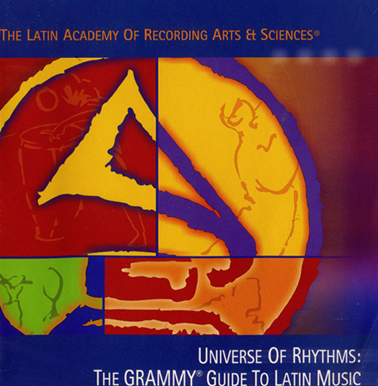 Produced for the 1st Annual Latin GRAMMY, September 13, 2000
Produced for the 1st Annual Latin GRAMMY, September 13, 2000
“Latin music” has never been more than a shorthand for a universe of rhythms and styles as diverse as the people who created them. For a while it was a useful convention. Not anymore. As technology and communications continue to erode borders, we are all fast becoming next-door neighbors. Latin artists are finding their place in North America’s mainstream culture while established Latin acts continue to grow. The 1st Annual Latin GRAMMYs, set for September 13, 2000, at Los Angeles’s Staples Center and to be aired on CBS and to an international audience, will underscore the importance of this trend.
As Latin music continues to impact the pop mainstream, we all need to be more, and better, informed.
The Recording Academy has assembled this primer as a refresher for those of us who already have a familiarity with Latin music and as a tool for anyone just starting to explore these sounds.
Take a quick tour through the exemplary tracks on this CD and read the brief descriptions of the musical styles represented here — from banda and ranchera to flamenco, samba and cumbia. There is no way one piece of music might represent the history and nuances of an entire universe of music. But we believe you’ll find this CD an enlightening and enjoyable place to start. And we hope to intrigue you into a more personal, deeper search into the extraordinary world of Latin music.
You will not be disappointed.
Fernando González
Executive Producer
Recording Academy’s Guide to Latin Music
1) Salsa
Willie Colon “Calle Luna, Calle Sol” from Lo Mato (Fania)
2) Merengue
Juan Luis Guerra and Francisco Ulloa “La Cosquillita” from Fogaraté (Karen)
3) Traditional
Trio Matamoros “Son de la Loma” from 20 Exitos Originales del Trio Matamoros (Kubaney)
4) Cumbia
Los Inmortales “La Pollera Colora” from Cumbia Cumbia – A Selection Of Colombian Cumbia Recordings (Discos Fuentes)
5) Vallenato
Alejo Durán “Alicia Adorada” from 16 Grandes Exitos (Discos Fuentes)
6) Ranchera
Lola Beltrán “Cucurrucucu Paloma” from Homenaje A Los Grandes Compositores (Orfeón)
7) Banda
Banda el Recodo de Cruz Lizarraga “El Sinaloense” from Homenaje a Don Cruz Lizarraga (La Sierra)
8) Grupero
Los Bukis “Tu Carcel” from 16 Exitos de Siempre (Fonovisa)
9) Tejano
Selena “Amor Prohibido” from Dreaming Of You (EMI Latin)
10) Norteño
Los Tigres del Norte “Banda del Carro Rojo,” from 16 Super Exitos (Fonovisa)
11) Tango
Anibal Troilo y su Orquesta “Quejas de bandoneon” from Anibal Troilo Obra completa en RCA Vol 5 (BMG Argentina)
12) Flamenco
Camarón de la Isla with Paco De Lucía y Tomatito “Bulerias de la Perla,” from Calle Real (Polygram Spain)
13) Latin Jazz
Machito and his Afro Cubans “Mambo Inn” from Tremendo Cumban (Tumbao)
14) Samba
Paulinho da Viola “Dança da Solidao” from Brazil Now (EMI)
15) Pagode
So Pra Contrariar “Sai Da Minha Aba (Biçao)” from So Pra Contrariar (BMG)
16) MPB
Milton Nascimento “Cais” from Clube da Esquina (EMI)
17) Sertanejo
Chitaozinho & Xororo “Bailao de Peao” from 20 Músicas do Siglo XX (Mercury/Polygram)
18) Rock en Español
Maldita Vecindad y los Hijos del 5to Patio “Pachuco” from El Circo (BMG)
Excerpt from the booklet:
1) Salsa
Willie Colon “Calle Luna, Calle Sol” from Lo Mato (Fania)
Salsa is a term of unclear origin that emerged and became popular in New York in the late 1960s. It has remained controversial since. For some, salsa is nothing more than a marketing handle for Afro-Cuban music as updated and reinterpreted by Latinos in New York. Others hear it as a distinctive New York-Caribbean style, pointing out the grittier sound and the pan-Latin elements (e.g.: Puerto Rican, Panamanian and Dominican as well as Afro-Cuban), along R&B and jazz influences.
Salsa es un término de origen incierto que surgió y se hizo popular en Nueva York al fin de la década de los 60. Y desde entonces ha sido controversial. Para algunos, salsa es solo un término de mercadeo para lo que ven como, música afro-cubana reinterpretada por los latinos de Nueva York. Otros la escuchan como un estilo original, caribeño-neoyorkino y señalan su sonido áspero, las influencias pan-latinas (p.ej: puertorriqueñas, panameñas y dominicanas además de la afro-cubana) y los elementos de R&B y jazz.
2) Merengue
Juan Luis Guerra and Francisco Ulloa “La Cosquillita” from Fogaraté (Karen)
While there are similarly named dances in other countries, this merengue, fast-paced music danced in a tight, two-step, is the national dance of the Dominican Republic. Born in the Dominican countryside in the 19th century of African and European traditions, merengue was traditionally played by small groups featuring accordion, guiro (metal scraper), and the two-headed tambora drum. It became enormously popular in the 1980s played by brassy, big band-like orchestras.
Aunque hay otras danzas del mismo nombre en otros países, este merengue, una música de pulso rápido bailada apretado, en un movimiento de dos pasos, es el baile nacional de la República Dominicana. Nacida en el campo en la Republica Dominicana en el siglo XIX de tradiciones europeas y africanas, el merengue era tradicionalmente tocado por pequeños grupos con acordeón, guiro y tambora. Se hizo enormemente popular en los años 80 interpretados por orquestas tipo big band.
